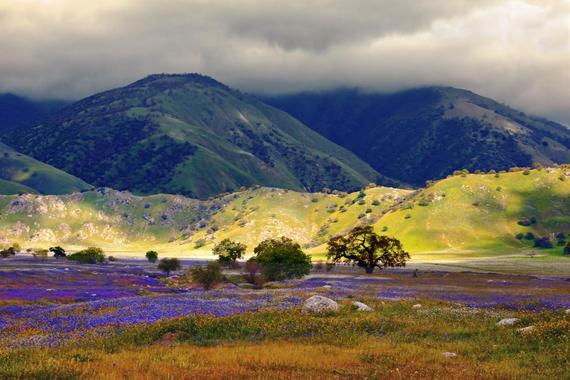When the 2,650-mile Pacific Crest Trail was envisioned in the 1930s, it was to traverse the highest points along the West Coast's mountainous spine between Mexico and Canada, revealing the majestic vistas and extraordinary natural riches that characterize the West. But the federal government couldn't get permission to build the trail through the Tejon Ranch, and hikers instead must walk through the Mojave Desert floor, alongside aqueduct roads, regarded by many hikers as the least appealing section of the trail.
This week, pursuant to a landmark 2008 conservation agreement, tangible actions were taken to move 38 miles of the Pacific Crest Trail onto the crest of the Tehachapi Mountains. The Tejon Ranch Conservancy received a 10,000-acre conservation easement from the Tejon Ranch Company preserving the expansive views that will be seen from the new section of the trail. The easement limits the construction of new roads and the buildings, protecting in perpetuity the sweeping landscape that will be visible to hikers and horseback riders on the new section of the trail.
This legal agreement will lead to relocating the Pacific Crest Trail through the heart of the conserved lands on Tejon Ranch.
In 2008, the Tejon Ranch Conservancy was created as part of the Tejon Ranch Conservation Agreement entered into between five environmental organizations, including NRDC, and the Tejon Ranch Company, preserving 240,000-acres of this vast undeveloped private landholding. It was an unprecedented act -- the product of a two-year negotiation -- to protect an irreplaceable landscape. The Conservancy was created with a two-part mission to preserve and enhance biodiversity and to share the wonders of Tejon Ranch through public access. Re-routing the Pacific Crest Trail onto Tejon Ranch was and is a central component of that public access vision.
For the first time, Pacific Crest Trail hikers and equestrians will be able to experience this remarkable landscape that sits at the unique crossroads of natural habitats and rare species. San Joaquin oak woodlands, Mojave Desert Joshua trees, the fir forests of the Sierra Nevada and the chaparral-studded South Coast Ranges all meet in an uncommon convergence here. This is the heart of condor country and the iconic birds can be seen soaring above rolling hills carpeted with spring wildflowers. Black bears, mountain lions and pronghorn roam free.
In its first five years the Conservancy has acquired over 100,000 acres of conservation easements, making it one of the largest land trusts in California. It has launched a service corps program, created a robust citizen science program partnering with hundreds to steward and document the ecological richness of Tejon Ranch. It has designed and begun to implement a public access program that allows the public to use and enjoy the Ranch. And it has created a land management plan that can serve as a model for other organizations.
With this week's announcement, the Tejon Ranch Conservancy has accomplished real progress toward a realignment of the Pacific Crest Trail that has defied the good intentions and best efforts of many others for generations.

